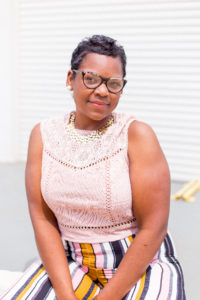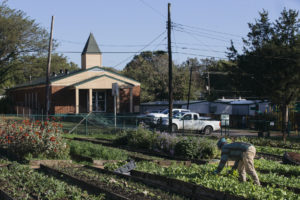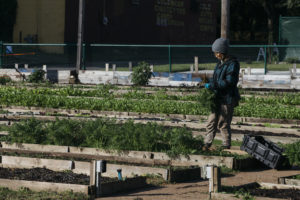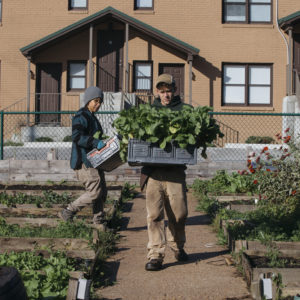by Meridith Miller-Rucker
If you ask Sankedra Clay-Hudson what inspires her to work towards a cleaner, greener Memphis, with a grin on her lips and a sparkle in her eye she may tell you, “I’m not only a client. I’m the playa president.”
The famous Notorious B.I.G. quote sums up a larger-than-life dedication that she brings to the table as Executive Director of Bloom 901, an urban-planning, people-focused non-profit that works to connect and empower neighborhood residents to create and maintain safe, green spaces.
“It’s lived experience,” She adds, recognizing the significant role access to outdoor space played in her personal growth and wellbeing as a young, single mother in Memphis. “My blocks were rough, but I could take my baby [to Riverside Park] for free and go there and dream.”
Equitable access to parks continues to fuel Clay-Hudson’s work to ensure lower-income residents with limited exposure to safe, clean neighborhood parks can experience outdoor spaces where they can learn and grow. Bloom’s role as a collaborator on Memphis’ Reimagining the Civic Commons is the project that she’s most proud to see come to fruition. The project began with The Fourth Bluff located in downtown Memphis on Front Street between Court and Jefferson, and included the River Line Trail, River Garden, Cossitt Library, and other spaces adjacent to the Mississippi riverfront. The Collaborative is a part of a national effort to transform public spaces that encourage residents to breakdown socioeconomic and cultural barriers and connect to nature. The Memphis River Parks Partnership serves as convener for this project that revitalized the downtown riverfront with innovative design that is increasing civic engagement while creating value and promoting environmental sustainability.
“I believe in Memphis River Parks because it worked for me,” she says. “That’s what I want for people.”
As the project prepares to branch out and foster similar, vibrant, equitable spaces across the city, the path uniquely mirrors Clay-Hudson’s transformational journey that was “born by the river” she says. Part of her work as the leading change-agent for Bloom involves assisting Park Friends Groups petition for land space. She makes it clear, though, that the residents are the true champions.

“When I go into a community, they’ve already been picking up trash, walking trails, painting with youth and cooking for the neighborhood,” Clay-Hudson says. “Our research shows that most of our communities have people who care. Bloom enhances and formalizes these networks. We authentically engage and connect the dots for high impact partnerships. We curate the community’s designs and help launch their plan.”


One of Bloom’s biggest accomplishments is the Memphis Parks Master Plan. Clay-Hudson says it’s the first comprehensive park pan Memphis has had In 20 years. The last plan was released in 1999. The importance and impact of community is something she recalls learning at a young age. In the 1980s, she grew up in Joseph A. Fowler Homes on South 4th street, the second housing project complex built in the United States after Chicago, Illinois’ Cabrini Green. After a series of unfortunate events that lead to her mother’s arrest, at age 5 she and one of her younger siblings moved in with their paternal grandmother. She attended LaRose Elementary which she describes as a true community school that gave her a sense of belonging.
“This is what gives me the affinity for community,” Clay-Hudson says. Experience also her gives her a keener understanding of the underserved populations she encounters through Bloom, which enables her to approach projects with transparency, tenacity, and heart. “During my time in social work, I realized we were coming to people with ready-made plans without asking them what they needed. I’m finding that it’s similar in the park space. It’s hard to get [people] to imagine a community garden when they’ve been missing swings for three or four weeks. I first work on their immediate, real-time needs. Then I’m able to [foster] a longer-lasting relationship to do other things.”

Along with the importance of community, Clay-Hudson credits the importance of timing and seizing opportunity for preparing her for success in environmental justice. After attending Vance Middle School, she used a Choice Transfer to attend East High where she got an early foot in the door to working for the City. “My first job was at 15 years old with Mayor W.W. Herenton’s Youth Initiative,” she says. “All of the things we couldn’t afford, I could do through programs such as Homework Hotline and Bridge Builders.”
As a first-generation college student, Clay-Hudson got her bachelor’s in political science from the University of Tennessee at Chattanooga and her Master of Business Administration from Christian Brothers University (CBU). Getting pregnant with two of her three children while in undergrad and having to move back home to navigate homelessness and public housing deepened her desire to build thriving, accessible communities in Memphis.
“I was struggling,” Clay-Hudson recalls. “Then I met Jacqueline Partee who was, at the time, Director of Community Services for the Memphis Housing Authority.” Partee became an influential mentor for Clay-Hudson. And helped her become a case manager.
While at CBU, Clay-Hudson shadowed the Business Development Officer of Community Lift, created the River City Capital Marketing Campaign, and wrote reports for the Federal Reserve of Memphis. She would later apply with Bloom after seeing the job advertisement.
“I wrote a proposal at 3 a.m. on the morning of my interview,” she says. “They called me back that evening and asked [for] copy to share with the board. Then they offered me the job.”
Clay-Hudson began working with Bloom on November 19, 2019. The projects she’s spearheading are helping to create the community environments and wrap-around services that helped her blossom into an indomitable force.
“I’m the rose that grew from the concrete,” says Clay-Hudson. “This city made me. We have greatness in these communities. We need to give residents what they deserve, and that’s an opportunity.”
Covid 19 inspired Clay-Hudson to secure grant funding for Bloom’s next big idea. “After I received a $10,000 reward to publish park manuals, I called back and suggested we be allowed to recalibrate and use the money to connect the homeless population in a meaningful way. [They] told me to put it in writing, and the rest is history.”
Under Clay-Hudson’s pivot proposal, Bloom secured a total of $50,000 as a part of the 10 Minute Walk Campaign, a national initiative led by The Trust for Public Land (TPL) in partnership with National Recreation and Park Association and the Urban Land Institute, to bolster nationwide efforts to ensure every neighborhood has access to a quality park within a 10-minute walk of every home by 2050. Of the 10 cities awarded in 2020, Memphis received one of the three largest awards tying with Pittsburg, Pennsylvania, and Metro-Philadelphia. According to Clay-Hudson, Bloom will collaborate with The Hospitality Club of Memphis and the Memphis Medical District to create a placemaking project in Morris Park at 747 Poplar Avenue. The Hospitality Hub’s Livable Work Program will help keep the park clean by scheduling workers assist with upkeep and foster a spirit of pride and responsibility. The Hub is also breaking ground on their women’s shelter. These are the kind of resources that she knows make all the difference to a family who has fallen on hard times.
“Even though our homeless population is in transition, they can still have a space. The presence of poverty is not the absence of community. We want to create something that they can come back and see and say, ‘This was a part of my story but not the end of my story’.” The total $50,000 award will go towards the revamping of Morris Park.
In the meantime, Clay-Hudson continues to lead the way in fostering intentional ways to best use the city’s urban spaces to serve the people.
“After Covid, parks truly became the commons again,” Clay-Hudson says. “Bloom became triage. We distributed over 500 meals to families through our parks. It helped us because the community saw us when they were looking for support.”
With a laugh, she adds, “I’m chief everything officer. I had to hold this baby because it meant too much to me to be mishandled, but we are now at a point where we are looking to hire and delegate.”
Though many see her work as heroic, Hudson looks to others for inspiration. She cites Marlon Foster, the creator of the Homework Hotline she used as a child and current Executive Director of Knowledge Quest, a youth social services organization that provides opportunities for youth and families to access healthy pathways, as her inspiration.
Ultimately Clay-Hudson sees herself on national panels sharing the keys to authentic community engagement for park practitioners. Until then, there’s much work to be done at home, but this she promises:
“We gon’ bloom, baby!” We want to keep the community connected. The city owes the people that, and I’m going to help them get it.”

